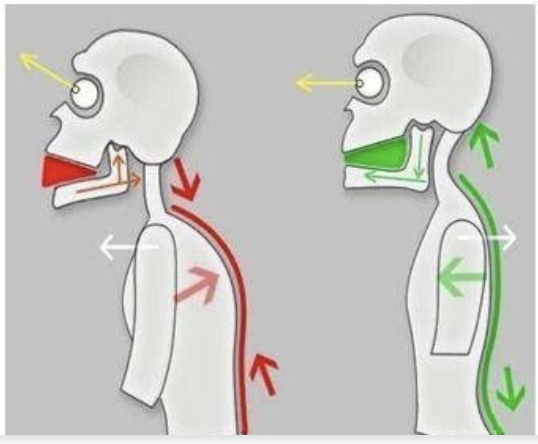
Is Your Posture Causing Your Jaw Pain & Headaches?
Written by Ashley Oyakawa, PT, DPT, OCS, CSCS
You have probably heard this time and time again: “It is important to have good posture, don’t slouch, shoulders back”. Right? Why do people nag about this all the time? To be fair, posture – albeit, an exhausted topic, is vital for your physical, emotional, and mental health.
Yes, that's right. Good posture isn't just for your physical health, but your emotional and mental health too!
So, let’s talk about this with a different mindset. Push all the nagging aside and let's imagine posture as your alignment and base of support.
The Concept of Alignment and Base of Support


This diagram represents each square as the relative body part, respectively. Now, imagine if these were boxes with objects inside of equal weight [Figure 1]. If someone were to push on these boxes, what would happen to the “head” box? That box may waver, titter-totter, or fall. To be clear, I am NOT saying your head will fall off. Don’t be so dramatic ;).
What I am trying to portray is that with a slouched trunk and a forward head, the alignment or how each segment is stacked upon each other is not ideal. In addition, this also changes your base of support which may cause other issues down the chain. So, I guess whomever nagged you about your posture was onto something.

Here we can see the radiology imaging [Figure 2] of the internal effects to the joints. Notice that there is less space between the vertebrae especially at this area (red arrows). From an engineer’s or mechanical standpoint, this demonstrates excessive compressive loading (red arrows) along with excessive shearing forces (green arrow) secondary to the poor alignment of the head on the neck.
Externally, you may notice a crease at the neck. Why is this there? Imagine if you had a pair of jeans and folded the jeans in the exact same way every single time. Eventually, where the jeans are folded, wrinkles then fraying would appear.
Unlock the Key: Thoracic Spine

[Figure 3]
Let’s add another element into the mix: mobility of the mid-back. In my opinion, this is the keystone (Insert emojis and icons: flashing lights, dozens of bright arrows, sparkles). Now, that I’ve got your attention, here is why: The mid-back (anatomically called the thoracic spine) and thorax is the attachment site for the arms and legs, so it is essentially your foundation.
The thoracic spine and thorax require a balance between mobility and stability to create that ideal foundation. If we are in a slouched posture (flexion) majority of the day, we slowly begin to lose mobility in the opposite direction (extension) creating stiffness of the thoracic spine. In today’s society, the majority of our actions and activities are in front of us – such as phone and computer use, writing, driving, etc. – which makes us predisposed to a slumped posture.
If there is stiffness of the thoracic spine, your body will be forced to move at other areas including your neck and low back as a compensatory strategy. So, if there is already excessive compressive and shearing forces at the neck from poor posture plus a compensatory strategy, this will begin to amass into potential pain or dysfunction. This is why I believe the thoracic spine and thorax is the key to unlock. See what I did there? ;)
Length-Tension Relationship of Musculature
In addition to joint impairments, there will also be an altered length-tension relationship to the surrounding the musculature: the muscles in the front of the neck and scapular musculature will be over lengthened, the muscles in the back of the neck and the chest musculature will be shortened. Think of muscles as springs. If the springs are overly stretched or overly shortened for a period of time, the elastic nature of the springs will be altered temporarily.
But, guess what? There is a bright side! Your brain and body are SO AMAZINGLY SMART! You will be able to retrain your brain and body. The general goal would be to improve the flexibility and mobility of the shortened musculature along with improving the activation and strength of the over lengthened musculature.
With the above visual representation and explanations, I am hoping you have a good understanding about the previous concepts. How does this correlate to jaw pain? Let’s zoom on in.
What is the Correlation to Jaw (Temporomandibular Joint) Pain?


[Figure 5] [Figure 6]
Once again, I will be using boxes to assist with the interpretation of the temporomandibular joint (TMJ). The TMJ is the articulation between the temporal bone with the mandibular bone [anatomical, Figure 4; cartoon, Figure 5]. This articulation is unique in that there are two TMJ, one on the right and one on the left, that must work in conjunction with each other for optimal functioning. There is also a disc within the joint that acts as a lubricator and shock absorber. Encapsulating the joint and disc is a capsule which provides stability.
The second diagram [Figure 6] represents what occurs with abnormal posture. Notice how the congruency of the TMJ is altered creating an automatic “poor starting position”. This is equivalent of beginning a race 10 feet behind the starting line then expecting to win the race. In addition, the poor alignment will affect the forces at the joints and the length-tension relationship of the surrounding musculature at the jaw. This will cause issues at the jaw including pain, clicking or popping, locking, and limited mobility.
What is the Correlation to Headaches?
So, how does posture and alignment relate to headaches? If you reflect back, I mentioned that the muscles in the back of the neck are shortened. Due to this, there is temporary excessive pressure at the respective nerves resulting in a headache.
How do you get the nerves to be “unsquished”? This is where we re-visit the length-tension relationship concept. If the muscles behind the neck/skull are shortened, let’s work on improving the relative flexibility. Once that improves, let’s focus on strengthening the over lengthened muscles at the front of the neck which provide stability.
What do you think? Of course, there are other variables that aggravate headaches such as stress, anxiety, fatigue, and external stimuli, however addressing the musculoskeletal component is one way where you can empower yourself and be proactive with your health.
As you can see, everything is related.
There is a concept in physical therapy called regional interdependence which describes the observation of a relationship between various body areas that is not specifically at the symptomatic area when addressing musculoskeletal issues.1 To address jaw pain and headaches, you cannot just zoom into the symptomatic area – you must zoom out and look at the upper quarter in its entirety. This “zoom out” outlook will not only be more effective, but it will also address the cause of your symptoms versus a “zoom in” lens will only address the source.
Here is a summary of the major concepts:
- Imagine posture as alignment and base of support
- Unlock the key: thoracic spine
- Length-tension relationship of musculature or springs
- Foundation = trunk/thorax
- Address the cause of your symptoms – not just the source
- Your brain and body are SO AMAZINGLY SMART
What do you think? Pretty simple, right?! I’m just kidding :D I know I wrote this blog with a sense of light-heartedness and humor and I am all too aware about the significance of this topic. But if this topic is relatable to you, I wanted to illustrate various viewpoints and management strategies that could be helpful. YOU are in charge of your health. Invest in YOU.
I am interested in your thoughts! Please let me know what you think in the comment section below. If you have any questions, please feel free to contact Evergreen Physical Therapy Specialists at (626) 683-8536 or at [email protected].
P.S. After writing this blog, I have realized I am also a very good cheerleader! PomPoms!

Ashley graduated from Creighton University in 2015 with her Doctorate of Physical Therapy. Ashley completed the Kaiser Southern California Orthopedic Residency program in 2017 and recently completed the Azusa Pacific University Movement System Fellowship program to advance clinical reasoning and knowledge. She is an Orthopedic Certified Specialist (OCS) from the American Board of Physical Therapy Specialists and a Certified Strength and Conditioning Specialist (CSCS) from the National Strength and Conditioning Association.
Schedule an appointment with Ashley today!
References
- Wainner RS, Whitman JM, Cleland JA, Flynn TW. Regional interdependence: a musculoskeletal examination model whose time has come. J Orthop Sports Phys Ther. 2007;37(11):658–60 [PubMed] [Google Scholar]
Stay connected with news and updates!
Join our mailing list to receive the latest news and updates from our team.
Don't worry, your information will not be shared.
We hate SPAM. We will never sell your information, for any reason.

